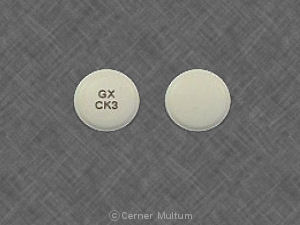Raxar Side Effects
Generic name: grepafloxacin
Note: This document contains side effect information about grepafloxacin. Some dosage forms listed on this page may not apply to the brand name Raxar.
Applies to grepafloxacin: oral tablet.
Warning
Grepafloxacin nasal was withdrawn from the U.S. market in 1999.
Take all of the grepafloxacin that has been prescribed for you even if you begin to feel better. Your symptoms may start to improve before the infection is completely treated.
Drink plenty of extra fluids every day while taking grepafloxacin.
Do not take antacids that contain magnesium or aluminum (e.g., Tums or Rolaids), the ulcer medicine sucralfate (Carafate), or vitamin or mineral supplements that contain iron or zinc for a minimum of 4 hours before or 4 hours after a dose of grepafloxacin. Taking antacids, sucralfate, or vitamin or mineral supplements too close to a dose of grepafloxacin can greatly decrease the effects of the antibiotic.
If you experience any of the following serious side effects, stop taking grepafloxacin (the active ingredient contained in Raxar) and seek emergency medical attention:
-
an allergic reaction (difficulty breathing; closing of your throat; swelling of your lips, tongue, or face; or hives);
-
irregular or slow heartbeats;
-
repeated fainting;
-
seizures;
-
confusion or hallucinations;
-
liver damage (yellowing of the skin or eyes, nausea, abdominal pain or discomfort, unusual bleeding or bruising, severe fatigue); or
-
muscle or joint pain.
If you experience any of the following less serious side effects, continue taking grepafloxacin and talk to your doctor:
-
nausea, vomiting, or diarrhea;
-
headache, lightheadedness, drowsiness, or insomnia;
-
ringing in your ears; or
-
increased sensitivity of the skin to sunlight.
Side effects other than those listed here may also occur. Talk to your doctor about any side effect that seems unusual or that is especially bothersome.
For Healthcare Professionals
Applies to grepafloxacin: oral tablet.
Other
Percentages below refer to patients treated on multiple-dose regimens.[Ref]
Gastrointestinal
Nausea and taste perversion (e.g. medicinal taste) are the most common adverse effects of grepafloxacin (the active ingredient contained in Raxar) occurring in as many as 11% to 16%, and 9% to 18% of patients, respectively. Other gastrointestinal effects including diarrhea, abdominal pain, vomiting, dyspepsia, anorexia, dry mouth, and constipation have been reported in 1% to 4% of patients. Abnormal stools, cheilitis, dysphagia, eructation, flatulence, gastritis, gastrointestinal disorder, gingivitis, glossitis, increased appetite, melena, mouth ulceration, oral moniliasis, rectal disorder, rectal hemorrhage, stomatitis, tenesmus, thirst, tongue discoloration, tongue disorder, and tongue edema have been reported in less than 1% of patients.[Ref]
Nervous system
Nervous system side effects have included headache, dizziness, insomnia, somnolence, and nervousness in 1% to 5% of patients. Abnormal dreams, abnormal gait, agitation, anxiety, confusion, depression, emotional lability, hallucinations, hyperkinesia, hypoesthesia, hypokinesia, paresthesia, speech disorder, stupor, thinking abnormality, tremor, and vertigo have been reported in less than 1% of patients.[Ref]
Genitourinary
Genitourinary side effects have included vaginitis and leukorrhea in up to 3% of patients. Albuminuria, balanitis, dysuria, hematuria, impotence, polyuria, urethral pain, uricaciduria, urinary frequency, urinary tract disorder, impaired urination, urine abnormality, and vulvovaginal disorder have been reported in less than 1% of patients.[Ref]
Dermatologic
Dermatologic side effects have included pruritus and rash in 1% to 2% of treated patients. Acne, alopecia, dry skin, epidermal necrolysis, exfoliative dermatitis, fungal dermatitis, herpes simplex, macropapular rash, skin disorder, sweating, urticaria, and vesiculobullous rash have been reported in less than 1% of patients.[Ref]
General
Non-specific side effects have included asthenia and pain in 1% to 2% of treated patients. Back pain, body odor, chest pain, chills, facial edema, fever, malaise, neck rigidity, and pelvic pain have been reported in less than 1% of treated patients.[Ref]
Cardiovascular
Cardiovascular side effects have included arrhythmia, hypotension, palpitations, peripheral vascular disorder, postural hypotension, syncope, tachycardia, and vasodilation in less than 1% of patients.[Ref]
Hematologic
Hematologic side effects have been reported in less than 1% of patients and have included anemia, eosinophilia, hypochromic anemia, leukocytosis, leukopenia, lymphadenopathy, lymphocytosis, lymphoma-like reaction, decrease in prothrombin, increase in prothrombin, reticuloendothelial hyperplasia, thrombocytopenia, and increased thromboplastin.[Ref]
Metabolic
Metabolic side effects have included dehydration, edema, electrolyte abnormality, gout, hyperglycemia, hyperlipidemia, hypernatremia, hyperuricemia, peripheral edema, and weight loss in less than 1% of patients.[Ref]
Musculoskeletal
Musculoskeletal side effects have been reported in less than 1% of patients and have included arthralgia and myalgia.[Ref]
Respiratory
Respiratory side effects have included asthma, atelectasis, bronchitis, dyspnea, epistaxis, hemoptysis, increased cough, laryngismus, pharyngitis, pleural effusion, rhinitis, and increased sputum in less than 1% of patients.[Ref]
Ocular
Ocular side effects have included amblyopia, conjunctivitis, dry eyes, eye pain, lacrimation disorder, and photophobia in less than 1% of patients.[Ref]
Other
Deafness, ear disorder, parosmia, taste loss and tinnitus have been reported in less than 1% of patients.[Ref]
Hepatic
Hepatic side effects have included abnormal liver function tests in greater than 1% of patients.[Ref]
More about Raxar (grepafloxacin)
- Check interactions
- Compare alternatives
- Drug images
- During pregnancy
- Drug class: quinolones and fluoroquinolones
Related treatment guides
References
1. Product Information. Raxar (grepafloxacin). Glaxo Wellcome. 2001;PROD.
2. Hook EW 3rd, McCormack WM, Martin D, Jones RB, Bean K, Maroli AN. Comparison of single-dose oral grepafloxacin with cefixime for treatment of uncomplicated gonorrhea in men. The STD Study Group. Antimicrob Agents Chemother. 1997;41:1843-5.
3. Goldstein EJ. Possible role for the new fluoroquinolones (levofloxacin, grepafloxacin, trovafloxacin, clinafloxacin, sparfloxacin, and DU 6859a) in the treatment of anaerobic infections: review of current information on efficacy and safety. Clin Infect Dis. 1996;23 Suppl 1:s25-30.
4. New oral fluoroquinolone marketed. Am J Health Syst Pharm. 1998;55:20.
5. Lode H, Vogel F, Elies W. Grepafloxacin: A review of its safety profile based on clinical trials and postmarketing surveillance. Clin Ther. 1999;21:61-74.
Further information
Always consult your healthcare provider to ensure the information displayed on this page applies to your personal circumstances.
Some side effects may not be reported. You may report them to the FDA.

